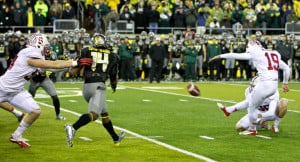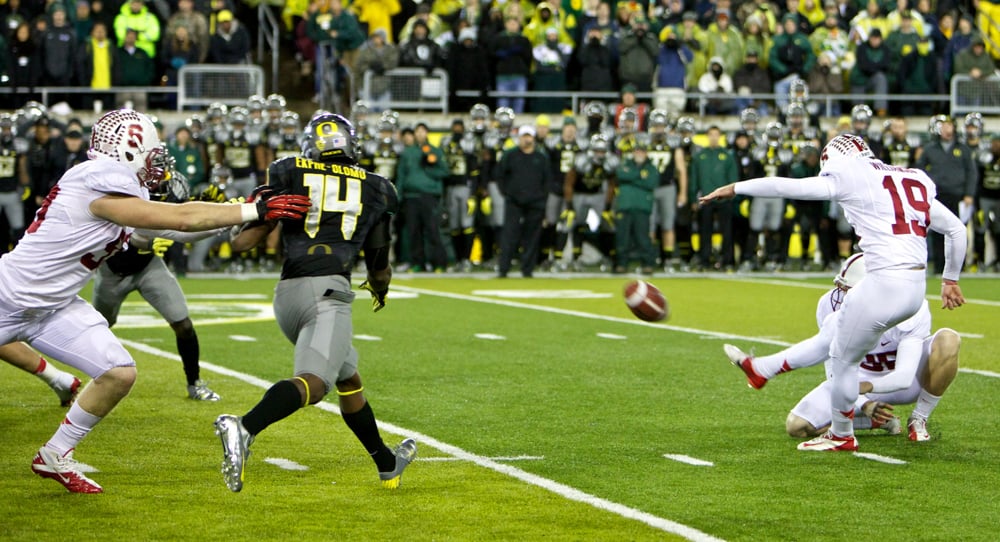With three seconds remaining in regulation and the score tied at 38, then-sophomore kicker Jordan Williamson walked out onto the turf at the University of Phoenix Stadium. After a career game for Andrew Luck, a Fiesta Bowl victory — and Stanford’s 12th win of the 2012 season — was on the line, to be determined by the flight of a football that was set 35 yards away from the goal posts and almost perfectly centered between the hashes.

Wide left.
Minutes later, Williamson was given another opportunity — this time, to put the Cardinal ahead in overtime. It was a 43-yarder from the right hash.
Wide left.
A football kicker’s psyche is often the first example that comes to mind when fans consider sports psychology. The field goal seems so routine, with the kicker going through the same motions on every attempt. Yet any single missed opportunity can send the athlete’s mental state into chaos, starting from the direct aftermath of the miss and leading to a complete loss of confidence and physical ability to kick a field goal.
Williamson’s missed kicks in the 2012 Fiesta Bowl could have led to a career-ending reaction.
“[They could have caused] a traumatic psychopathology, like post-traumatic stress disorder,” said Hans Steiner, professor emeritus of psychiatry and human development, “meaning that [the athlete is] experiencing flashes of the moment.”
But 10 months later, Williamson had another massive opportunity: a 37-yard field goal in overtime at Oregon to hand the Ducks their first loss and propel the Cardinal to a potential Rose Bowl berth. This time, the kick was true.
“As soon as I got done being at the bottom of that pile and I hopped up, I thought to myself, ‘Wow. It’s been a full circle. It’s practically been a year and the complete opposite situation’,” Williamson said. “As much as I hated missing those kicks in the Fiesta Bowl, and as much as I wish the team had gotten a win and that we would’ve won the Fiesta Bowl, I can say, for my personal growth, it was needed.”
Dealing with failure is key to performing well as a student-athlete, especially considering the poise that’s often associated with the role and the high expectations at Stanford. The historic success of the women’s basketball program, which has amassed a 768-154 (.833) record in its 28 seasons under head coach Tara VanDerveer, has raised the team’s expectations to extraordinary levels.
“In a sense, almost every game we go into we’re expected to win. So I think that’s the hardest part, where the pressure is not to lose,” said senior Toni Kokenis, who has medically retired and is not playing this season. “It’s almost like you can get into the mindset of — instead of playing to win — you’re playing not to lose, which is an interesting tension.”
According to Ahmed Raza Khan, a first-year child psychiatry fellow in the School of Medicine, the high expectations in situations like these — a win being expected in almost every game — often prevent players from feeling rewarded for their good, consistent performances; they only feel castigated after a defeat.
“That can affect not just your outlook, but your mental state and happiness,” Khan said.
An issue just as pressing for student-athletes at Stanford is being able to juggle academic and athletic responsibilities with the constant tug-of-war between the student-athlete, parents and coach — what Steiner refers to as the “unholy triad.”
“None of these three people want to have a look at this being too hard, too demanding, too problematic,” Steiner said.
“I remember telling my parents freshman year that I was being pulled in a million different directions,” said Haley Rosen, a junior on the women’s soccer team. “What’s crazy, too, is how much we put in mentally, physically, emotionally and time, and at the end of the day, everything we give is in the power of our coach…our happiness, our time schedules. That’s just crazy how as a student-athlete, you have so little control over the events that happen in your life.”
This lack of control and prolonged stress can cause more serious problems: body-image issues and eating disorders in women and addictive tendencies in men as well as depression. Detection, and hence treatment, is especially difficult in these situations because psychological conditions and other mental factors can be masked by athletic success.
While psychologists and psychiatrists often have to consider how to treat the negative responses that student-athletes have to their environments, they also play a role in helping the student-athletes optimize their performance in high-pressure competition situations.
Rick Schavone, the 35-year head coach of Stanford’s men’s and women’s diving teams, never competed in diving during his time as a student-athlete at the University of New Hampshire. Yet the four-time NCAA Diving Coach of the Year is one of the most successful instructors in the sport in large part due to his approach to the sport through a psychological lens, one he attained while earning a sports psychology degree at Stanford.
Schavone certainly sounded like a scientist as he surgically broke down how he prepares his divers to deal with anxiety in high-pressure meets.
“Under anxiety, there’s an increased blood flow to the large muscle groups,” he said. “So I don’t worry if they’re not making a dive in practice, knowing that in the meet they’ll get the extra zip that a mother gets to take a car off her baby…Under anxiety, concentration is more difficult, so I ask them to focus on the visual part of the dive.”
A particularly interesting consideration in diving is the balance between the individual and team components of the sport. While student-athletes compete as a unit for team credit, strong individual performances determine Olympic trial qualifications and allow a diver to gain recognition.
“The weakest way to go to battle is by yourself,” Schavone said. “If a team has cohesion or has good group dynamics, it’s going to have good performance. At Stanford, getting people to follow a leader is not an easy thing. A lot of the characters here are strong individuals.”
Ultimately, Stanford teams are utilizing sports psychology more to optimize student-athlete performance as its recognition and availability increases for Stanford athletes. However, awareness of the psychological issues that student-athletes are often exposed to is important in order to ensure their mental health.
“Being psychiatrically ill and being an elite athlete does not mix,” Steiner said. “It’s oil and water, and sooner or later, it catches up to you.”
Contact Jordan Wallach at jwallach ‘at’ stanford.edu.
